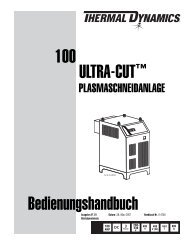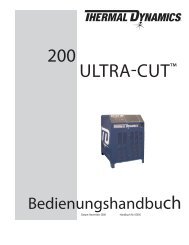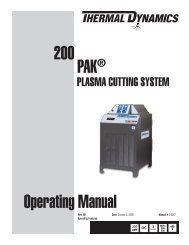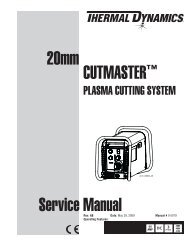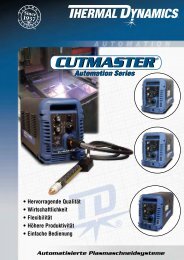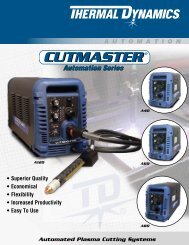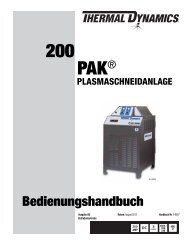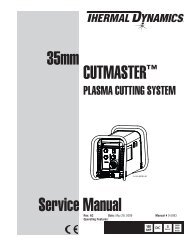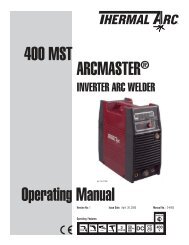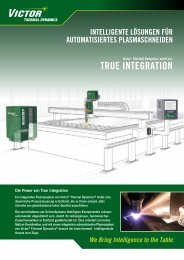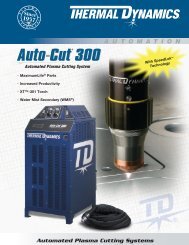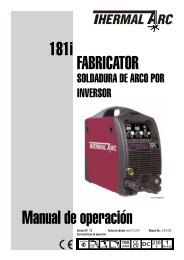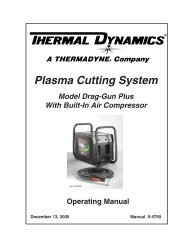211i Operating Manual FabricatOr® - Victor Technologies - Europe
211i Operating Manual FabricatOr® - Victor Technologies - Europe
211i Operating Manual FabricatOr® - Victor Technologies - Europe
Create successful ePaper yourself
Turn your PDF publications into a flip-book with our unique Google optimized e-Paper software.
FABRICATOR <strong>211i</strong> BASIC WELDING<br />
Making Welded Joints<br />
Having attained some skill in the handling of an electrode, you will be ready to go on to make up welded<br />
joints.<br />
A. Butt Welds<br />
Set up two plates with their edges parallel, as shown in Figure 4-21, allowing 1.6mm to 2.4mm gap between<br />
them and tack weld at both ends. This is to prevent contraction stresses from the cooling weld metal<br />
pulling the plates out of alignment. Plates thicker than 6.0mm should have their mating edges bevelled to<br />
form a 70º to 90º included angle. This allows full penetration of the weld metal to the root. Using a 3.2mm<br />
E7014 electrode at 100 amps, deposit a run of weld metal on the bottom of the joint.<br />
Do not weave the electrode, but maintain a steady rate of travel along the joint sufficient to produce a<br />
well-formed bead. At first you may notice a tendency for undercut to form, but keeping the arc length<br />
short, the angle of the electrode at about 20º from vertical, and the rate of travel not too fast, will help<br />
eliminate this. The electrode needs to be moved along fast enough to prevent the slag pool from getting<br />
ahead of the arc. To complete the joint in thin plate, turn the job over, clean the slag out of the back and<br />
deposit a similar weld.<br />
20°-30°<br />
Tack Weld<br />
Electrode Tack Weld<br />
Figure 4-21: Butt Weld<br />
Art # A-07698<br />
Figure 4-22: Weld Build up Sequence<br />
Art # A-07697_AB<br />
Heavy plate will require several runs to complete the joint. After completing the first run, chip the slag<br />
out and clean the weld with a wire brush. It is important to do this to prevent slag being trapped by the<br />
second run. Subsequent runs are then deposited using either a weave technique or single beads laid down<br />
in the sequence shown in Figure 4-22. The width of weave should not be more than three times the core<br />
wire diameter of the electrode. When the joint is completely filled, the back is either machined, ground or<br />
gouged out to remove slag which may be trapped in the root, and to prepare a suitable joint for depositing<br />
the backing run. If a backing bar is used, it is not usually necessary to remove this, since it serves a similar<br />
purpose to the backing run in securing proper fusion at the root of the weld.<br />
B. Fillet Welds<br />
These are welds of approximately triangular cross-section made by depositing metal in the corner of two<br />
faces meeting at right angles. Refer to Figure 4-14.<br />
A piece of angle iron is a suitable specimen with which to begin, or two lengths of strip steel may be<br />
tacked together at right angles. Using a 3.2mm E7014 electrode at 100 amps, position angle iron with<br />
one leg horizontal and the other vertical. This is known as a horizontal-vertical (HV) fillet. Strike the arc<br />
and immediately bring the electrode to a position perpendicular to the line of the fillet and about 45º from<br />
the vertical. Some electrodes require to be sloped about 20º away from the perpendicular position to<br />
prevent slag from running ahead of the weld. Refer to Figure 4-23. Do not attempt to build up much larger<br />
than 6.4mm width with a 3.2mm electrode, otherwise the weld metal tends to sag towards the base, and<br />
undercut forms on the vertical leg. Multi-runs can be made as shown in Figure 4-24. Weaving in HV fillet<br />
welds is undesirable.<br />
BASIC WELDING GUIDE 4-14 <strong>Manual</strong> 0-5225



